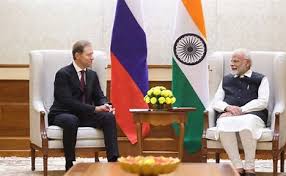 India called it a major diplomatic victory when China agreed to pull back 750 PLA soldiers engaged in an eyeball-to-eyeball situation at Chumar. The PLA may still be nibbling at Indian Territory in Eastern Ladakh, and it does so from a position of strength. Beijing has recently expressed the “undeniable fact” of the existence of a “huge dispute” with India.
India called it a major diplomatic victory when China agreed to pull back 750 PLA soldiers engaged in an eyeball-to-eyeball situation at Chumar. The PLA may still be nibbling at Indian Territory in Eastern Ladakh, and it does so from a position of strength. Beijing has recently expressed the “undeniable fact” of the existence of a “huge dispute” with India.
Against this backdrop, to expect the burgeoning economic engagement and trade relations to serve as leverage in settling the longstanding boundary issue would be a mistake. When Prime Minister Modi visits Beijing, mere symbolism and the pursuit of the economic agenda are unlikely to provide enduring results. The issues mainly stem from geopolitics and strategic mistrust. The question, therefore, is whether Modi can make a fundamental shift and find a common strategic ground with China.
For too long, India has recklessly followed the ‘containing China’ attitude, without understanding what it means or working towards actualizing it. Implementing the idea is obviously difficult; even catching up with China would take decades. A realistic assessment is, therefore, necessary without getting carried away by what the West says.
Modi’s visit will assume greater significance only if he were to make it his mission to change the India-China discourse metaphysically in India’s favour. The time for that has now come. Rethinking our approach to China must start with two basic premises. Firstly, the casting of China as a villain in Asia becomes inane when Beijing has achieved integration not only with all regional systems of Asia but also with markets in America, Europe and Africa. Some may grudgingly deny it but even our friend Russia is pivoting towards China. America’s ties with China are a matter of great-power politics; hence a complex issue. But we can be sure that the West would play on Indian sentiment to sustain India-China competition. What may happen in the distant future is something that one cannot say at present. India should not waste time thinking about limiting China’s rise now.
Secondly, drumming up the ‘China threat’ is a conspicuously misplaced notion. In actuality, barring its sponsorship of Maoist movements in the 1960s, China has never carried any messianic idea, just as India has never professed such a belief. If we take the long historical view, the rationale behind Chinese and Indian campaigns, including the fabled Silk Road and Spice Route reaching up to Arab lands and Europe, were economic in nature. They were never menacing and instead laid the foundation for Asian socio-economic systems that later became an attractive object for European colonizers. The spread of Indic thought changed the face of Asia and strengthened China’s nationhood. In contrast, India remained a killing field for zealots and colonial interventionists for centuries, with immense consequences for the nation’s unity. The ‘expansionist’ narrative therefore helps others sustain Asian rifts and smoothly implement their own projects.
In today’s India, the narrow nationalism, if not paranoia, built on the burden of 1962 seems only artificial. But, can Modi and Xi move beyond this burden and change the bilateral discourse?
Without admitting defeat, India should start to work on the non-conflicting nature of India-China links woven by centuries-old philosophical and commercial interfaces. The two are intrinsic and interdependent and still provide cues for the future. President Xi Jinping is reviving commerce by revitalizing the ancient Silk Route, on which Indian goods and culture spread to the East. That is a good thing. In fact, trade and commerce are the driving force of India-China relations today.
Xi is definitely seeking a fresh intellectual common ground for he also knows that mere economic hand-outs cannot quell sentiments in Xinjiang, Tibet and in China itself. Xi still faces resistance from hardliners in his party. They are seemingly unprepared to explore the prospect for change. But, ultimately only India can help China mitigate its internal cultural contradictions.
Can Modi now spin the wheel of Dharma that connected India and China through time and space? Buddhism could still become the prime mover of the relationship. India’s conclusive image in popular Chinese perceptions irrefutably revolves around the Buddha – a reason why common Chinese carry no ill-will against India in spite of the half a century long chill in the relationship.
China is changing rapidly and the challenge before Modi is how to reach out to 600 million Chinese followers of Dharma. In fact, any China-India congruity would come only on this hard reality of shared philosophy, geography, and economic resurgence. This could also spring surprises just as they occurred in Europe. But if oiled and maintained well, the shared philosophy, geography and economic interests could actually take India-China partnership to a new height in the 21st century.
To be sure, Indian and Chinese interests cannot be perfectly aligned. But for mutual benefit and for the common good of Asia, the challenge before the two countries is to find a harmonious balance of influence on a range of issues, including their core interests in the South China Sea and Indian Ocean Region. For that, they need to move away from the balance of power mind-set and evolve a symbiotic interdependency equation. Something like this is already evolving between Russia and China now.
So far, governments have failed to work on these calculations because they have tended to confuse goals with policies. India’s China policy has until now carried elements that contradicted each other – met narrow objectives but went against broader objectives. Modi needs to make an in-depth review of the real threats and opportunities of cooperating with China. If India’s primary goal is to regain its economic strength and cultural prestige, a frank dialogue with China transcending the boundary issue is vital.
Surely, the job of achieving this cannot be confined to the diplomatic and intelligence communities. Prime Minister Modi should take the dialogue beyond bureaucratic institutions to a higher plane. The outcome will surely make the course of action easier and trade-offs could be made with a minimum loss of face. This will give Modi’s leadership success in its entirety.
Author Profile
- India Writes Network (www.indiawrites.org) is an emerging think tank and a media-publishing company focused on international affairs & the India Story. Centre for Global India Insights is the research arm of India Writes Network. To subscribe to India and the World, write to editor@indiawrites.org. A venture of TGII Media Private Limited, a leading media, publishing and consultancy company, IWN has carved a niche for balanced and exhaustive reporting and analysis of international affairs. Eminent personalities, politicians, diplomats, authors, strategy gurus and news-makers have contributed to India Writes Network, as also “India and the World,” a magazine focused on global affairs.
Latest entries
 India and the WorldNovember 26, 2025G20@20: Africa’s Moment – The Once and Future World Order
India and the WorldNovember 26, 2025G20@20: Africa’s Moment – The Once and Future World Order DiplomacyOctober 4, 2025UNGA Resolution 2758 Must Not Be Distorted, One-China Principle Brooks No Challenge
DiplomacyOctober 4, 2025UNGA Resolution 2758 Must Not Be Distorted, One-China Principle Brooks No Challenge India and the WorldJuly 26, 2025MPs, diplomats laud Operation Sindoor, call for national unity to combat Pakistan-sponsored terror
India and the WorldJuly 26, 2025MPs, diplomats laud Operation Sindoor, call for national unity to combat Pakistan-sponsored terror India and the WorldJuly 25, 2025When Fire Ends, Diplomacy Begins
India and the WorldJuly 25, 2025When Fire Ends, Diplomacy Begins







